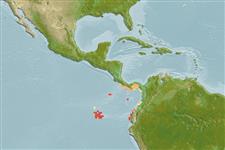>
Ovalentaria/misc (Various families in series Ovalentaria) >
Pomacentridae (Damselfishes) > Microspathodontinae
Etymology: Stegastes: Greek, stegastos, -e, -on = covered (Ref. 45335).
Environment: milieu / climate zone / depth range / distribution range
Ecologia
marino associati a barriera corallina; non migratori; distribuzione batimetrica 1 - 20 m (Ref. 9334). Tropical; 9°N - 2°S, 92°W - 77°W
Eastern Pacific: Costa Rica and from Cocos, Malpelo and Galapagos islands (Ref. 9334).
Size / Peso / Age
Maturity: Lm ? range ? - ? cm
Max length : 13.0 cm SL maschio/sesso non determinato; (Ref. 7247); Età massima riportata: 27 anni (Ref. 52465)
Short description
Chiavi di identificazione | Morfologia | Morfometria
Spine dorsali (totale) : 12; Raggi dorsali molli (totale) : 15 - 16; Spine anali: 2; Raggi anali molli: 12 - 13. Exhibits geographic color variations.
Adults inhabit coral and rocky reefs (Ref. 9334). Omnivorous (Ref. 9334). Adults are territorial and aggressive, vigorously driving off other fishes and certain invertebrates from their feeding and reproductive territories. They graze on algae and invertebrates including tubeworms, small crustaceans, and the tentacles of anemones (Ref. 28023). Oviparous, distinct pairing during breeding (Ref. 205). Eggs are demersal and adhere to the substrate (Ref. 205). Males guard and aerate the eggs (Ref. 205).
Life cycle and mating behavior
Maturities | Riproduzione | Spawnings | Egg(s) | Fecundities | Larve
Oviparous, distinct pairing during breeding (Ref. 205). Eggs are demersal and adhere to the substrate (Ref. 205). Males guard and aerate the eggs (Ref. 205).
Allen, G.R., 1991. Damselfishes of the world. Mergus Publishers, Melle, Germany. 271 p. (Ref. 7247)
IUCN Red List Status (Ref. 130435)
Threat to humans
Harmless
Human uses
Strumenti
Special reports
Download XML
Fonti Internet
Estimates based on models
Preferred temperature (Ref.
123201): 23.5 - 28.1, mean 24.4 °C (based on 27 cells).
Phylogenetic diversity index (Ref.
82804): PD
50 = 0.5000 [Uniqueness, from 0.5 = low to 2.0 = high].
Bayesian length-weight: a=0.01950 (0.00893 - 0.04257), b=2.99 (2.81 - 3.17), in cm total length, based on LWR estimates for this Genus-body shape (Ref.
93245).
Trophic level (Ref.
69278): 3.0 ±0.39 se; based on food items.
Generation time: 1.5 ( na - na) years. Estimated as median ln(3)/K based on 1
growth studies.
Resilienza (Ref.
120179): Basso, tempo minimo di raddoppiamento della popolazione 4.5 - 14 anni (tmax=27).
Fishing Vulnerability (Ref.
59153): Low vulnerability (19 of 100).
Nutrients (Ref.
124155): Calcium = 108 [57, 166] mg/100g; Iron = 0.778 [0.466, 1.256] mg/100g; Protein = 18.4 [17.3, 19.5] %; Omega3 = 0.112 [0.069, 0.179] g/100g; Selenium = 24.3 [13.9, 45.4] μg/100g; VitaminA = 72.6 [21.9, 237.1] μg/100g; Zinc = 1.61 [1.09, 2.29] mg/100g (wet weight);
